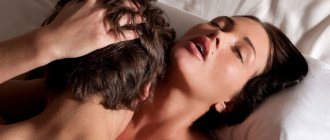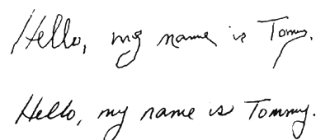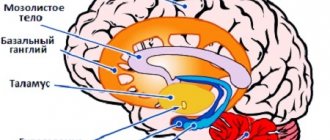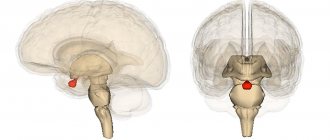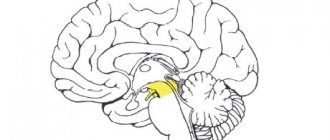| Striatum | |
| lat. corpus striatum | |
| Striatum. | |
| Catalogs | |
| |
| Media files on Wikimedia Commons |
Striped body
(lat. corpus striatum) - anatomical structure of the telencephalon, belonging to the basal ganglia of the cerebral hemispheres. In horizontal and frontal sections of the brain, the striatum appears as alternating stripes of gray matter and white matter. The striatum includes the caudate nucleus and the lentiform nucleus.
Functions[ | ]
The striatum regulates muscle tone, reducing it; participates in the regulation of the work of internal organs; in the implementation of various behavioral reactions (food-procuring behavior); participates in the formation of conditioned reflexes. When the striatum is destroyed, the following occurs:
- hypertonicity of skeletal muscles,
- disturbance of complex motor reactions and food-procuring behavior;
- the formation of conditioned reflexes is inhibited.
The ventral striatum and nucleus accumbens regulate reward and reinforcement in the brain. The dorsal part of the striatum is more involved in regulating motor functions. The dorsal part is also associated with the presence of impulsive behavior.[2][3][4][5][6]
Basal ganglia structure, development, functions
In the article we will talk about the basal ganglia
What is it and what role does this structure play in human health? All questions will be discussed in detail in the article, after which you will understand the importance of absolutely every detail in your body and head
Basal ganglia: physiology
These nuclei are located near the cerebral hemispheres. They have many long processes called axons. Thanks to them, information, that is, nerve impulses, is transmitted to different structures of the brain.
The basal nuclei can be considered the red and caudate nuclei, globus pallidus, putamen, substantia nigra and reticular formation.
The structure of the basal ganglia is varied. Basically, according to this classification, they are divided into those that belong to the extrapyramidal and limbic system. Both of these systems have a huge impact on the functioning of the brain and are in close interaction with it. They affect the thalamus, parietal and frontal lobes. The extrapyramidal network consists of the basal ganglia. It completely permeates the subcortical parts of the brain, and it has a major influence on the functioning of all functions of the human body. These modest formations very often remain underestimated, and yet their work has not yet been fully studied.
The functions of the basal ganglia are not many, but they are significant. As we already know, they are strongly connected to all other brain structures. Actually, from the understanding of this statement the main functions of the kernels follow:
- Control over the implementation of integration processes in higher nervous activity.
- Influence on the functioning of the autonomic nervous system.
- Regulation of human motor processes.
What are they involved in?
There are a number of processes in which nuclei are directly involved. The basal ganglia, the structure, development and functions of which we are considering, are involved in the following actions:
- affect a person’s dexterity when using scissors;
- accuracy of driving nails;
- reaction speed, dribbling the ball, accuracy of hitting the basket and dexterity of hitting the ball when playing basketball, football, volleyball;
- control of the voice while singing;
- coordination of actions while digging the earth.
New research has shown that the basal ganglia can also influence the type of movement:
- controllable or sudden;
- repeated many times or new, completely unknown;
- simple monosyllabic or sequential and even simultaneous.
In ordinary life, the basal ganglia simply transmit impulses that come from the frontal lobes to other brain structures. The goal is to purposefully perform known actions without stressing the central nervous system. However, in dangerous situations, the ganglia switch and allow a person to automatically make the most optimal decision.
Lesions of the basal ganglia can be very different. Let's look at some of them. These are degenerative lesions of the human brain (for example, Parkinson's disease or Huntington's chorea). These may be hereditary genetic diseases that are associated with metabolic disorders. Pathologies characterized by malfunctions of enzyme systems. Diseases of the thyroid gland can also occur due to disturbances in the functioning of the nuclei. Possible pathologies resulting from manganese poisoning. Brain tumors can affect the functioning of the basal ganglia, and this is perhaps the most unpleasant situation.
Important “nicergoline”: instructions for use, reviews, analogues
Notes[ | ]
- ↑ 1234
Striatum // Fundamental Model of Anatomy - L. M. Yager, A. F. Garcia, A. M. Wunsch, S. M. Ferguson.
The ins and outs of the striatum: Role in drug addiction (English) // Neuroscience. — 2015-08. - Vol. 301. - P. 529–541. - doi:10.1016/j.neuroscience.2015.06.033. - M. Foster Olive, Taylor, Lewis.
The neurocircuitry of illicit psychostimulant addiction: acute and chronic effects in humans (English) // Substance Abuse and Rehabilitation. — 2013-02. - P. 29. - ISSN 1179-8467. - doi:10.2147/SAR.S39684. - Sergi Ferré, Carme Lluís, Zuzana Justinova, César Quiroz, Marco Orru.
Adenosine-cannabinoid receptor interactions. Implications for striatal function: Adenosine-cannabinoid receptor interactions // British Journal of Pharmacology. — 2010-06. - Vol. 160, iss. 3. - P. 443–453. - doi:10.1111/j.1476-5381.2010.00723.x. - Nestler, Eric J. (Eric Jonathan), 1954-.
Molecular neuropharmacology: a foundation for clinical neuroscience. — 2nd ed. — New York: McGraw-Hill Medical, 2009. — 1 online resource p. — ISBN 978-0-07-164119-7, 0-07-164119-X, 0-07-148127-3, 978-0-07-148127-4, 978-1-281-79174-0, 1- 281-79174-1. - BaekSun Kim, Heh‐In Im.
The role of the dorsal striatum in choice impulsivity // Annals of the New York Academy of Sciences. — 2019-09. - Vol. 1451, iss. 1. - P. 92–111. — ISSN 1749-6632 0077-8923, 1749-6632. - doi:10.1111/nyas.13961.
Associated disorders
Most striatum-related disorders and diseases affect movement, both voluntary and automatic. Parkinson's disease and Huntington's disease are two major examples of basal ganglia dysfunction.
However, some psychological changes appear to depend on the functioning of this structure, mainly due to its role in the brain's reward system.
Parkinson's disease
Parkinson's disease causes lesions in the brain, mainly in the basal ganglia. The death of dopaminergic neurons in the substantia nigra prevents the release of dopamine in the striatum, causing motor symptoms such as slowness, rigidity, tremors and postural instability. Depressive symptoms are also produced.
Important Transverse cervical nerve and other nerves of the cervical spine
Huntington's disease
At the initial stage, Huntington's disease mainly affects the striatum; This explains why early symptoms are related to motor control, emotions and executive functions. In this case, the basal ganglia are unable to restrain unnecessary movements and hyperkinesia occurs.
Bipolar disorder
Research shows that in some cases of bipolar disorder, there are changes in genes that regulate striatal function. Evidence in this regard has been found for both bipolar disorder type I and type II.
Related article: "Bipolar Disorder: 10 Features and Curiosities You Didn't Know"
Obsessive-compulsive disorder and depression
Obsessive-compulsive disorder and depression, which have a similar biological basis, have been associated with dysfunctions in the striatum. This explains the decrease in mood that occurs in both disorders; Difficulty inhibiting movements is also a factor in OCD.
You may be interested: "Are there several types of depression?"
Dependencies
Dopamine is a neurotransmitter involved in the brain's reward system; the pleasurable sensations we experience when dopamine is released in the basal ganglia explain our motivation to return to seeking experiences that we know are pleasurable. This explains cravings from a physiological point of view.
Histology
The caudate nucleus and putamen are similar in histological structure. The gray matter of these nuclei consists of two types of cellular elements: small and large cells. Small cells, up to 15-20 microns in size, with short dendrites and thin axons, have delicate granulation and a large nucleus with a nucleolus. Large cells, up to 50 microns in size, are mostly triangular and polygonal, their nucleus is often located eccentrically, the protoplasm contains chromatin grains and in the vicinity of the nucleus there is a large amount of yellow lipoid pigment. These cells are normally surrounded by satellites. The ratio of large to small cells in the caudate nucleus and putamen is on average 1:20. Both small and large cells have long axons that can be traced to other deep structures of the brain.
Rice. 1. Scheme of the main connections of the extrapyramidal system (according to S. and O. Vogt): 1 - cortex prefrontalis; 2 - tractus frontothalamicus; 3 - nucleus caudatus; 4 - thalamus; 5—nucleus medialis thalami; 6 and 25 - nucleus ventralis thalami; 7 - nucleus campi Forell (BNA); 8 - nucleus subthalamicus; 9 —decussatio Foreli (BNA); 10 - nucleus ruber; 11 - substantia nigra; 12 - comissura post.; 13 - nucleus Darkschewitschi; 14 - nucleus interstitialis; 15 - pedunculi cerebelli superiores (tractus cerebellotegmentalls); 16 - cerebellum; 17 - nucleus dentatus; 18 - pedunculi cerebelli medii; 19 - nucleus vestibularis sup.; 20 - canalis semicirculatis; 21 - nucleus vestibularis lat.; 22 - fasciculus longitudinalis medius; 23 - fasciculus rubrospinalis; 24 - crus cerebri; 26 - globus pallidus; 27 - putamen; 28 - area gigantopyramidalis; 29 - capsule interna.
Rice. 2. Putamen. Cells at high and low magnification.
Rice. 3. Globus pallidus. Cells at high and low magnification.
Certain relationships between cellular elements and fibers allowed Vogt (O. Vogt) to point out the similarity of the structure of the striatum with the cortex. In the caudate nucleus, under the ependyma, there is a zone poor in fibers; the outer part of this zone is poor in ganglion cells, the inner part is richer in them. Deeper is a layer of tangential fibers containing a small number of ganglion cells. Based on this, Vogt developed a diagram of the structural and functional organization of the striatum (color Fig. 1): striopetal fibers end on small cells, closely connected with each other and with large cells, from which striofugal fibers begin. In small cells the fibrils are not differentiated, in large cells they are distributed in bundles. There are few myelin fibers in the striatum; most of them arise in the striatum itself and serve to connect to the pallidum; between the bundles of myelinated fibers there is a dense network of unmyelinated ones. A rich network of neuroglia surrounds nerve cells and nerve fibers. The pallidum contains only very large cells of various shapes - pyramidal, spindle-shaped, multipolar with long dendrites (colored Fig. 2 and 3). There are many chromatophilic clumps in the protoplasm. The surface of the cells is covered with loop-shaped terminal bodies - the ends of unmyelinated fibers surrounding the cells and myelin fibers. There are many more myelin fibers than gray matter; this explains the pale color of the kernel.
It’s important to “take it”: reviews from doctors and patients, instructions
The blood supply to the basal ganglia is carried out mainly from the middle cerebral artery (a. cerebri media), with branches going to the striatum (rr. striati). The branches of the anterior cerebral artery (a. cerebri anterior) also take part in the blood supply to the basal ganglia. All basal ganglia, especially the striatum, are very rich in capillaries; the distribution of capillaries in the striatum resembles that in the cortex; with lesions of the cerebral vessels, areas of softening especially often appear in the striatum.



